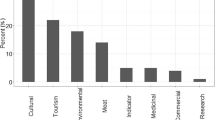Abstract
After providing background on Dendrolagus species in Australia, two consecutive surveys ofBrisbane's residents are used to assess public knowledge of tree-kangaroos and the stated degree of supportfor their conservation in Australia. The responses of participants in Survey I are based on their pre-surveyknowledge of wildlife. The same set of participants completed Survey II after being provided with additionalinformation on all thewildlife speciesmentioned in Survey I.Changes in the attitudes of respondents and theirdegree of support for the protection and conservation of Australia's tree-kangaroos are measured, includingchanges in their contingent valuations and stated willingness to provide financial support for such conservation.Reasons for wanting to protect tree-kangaroos are specified and analysed. Furthermore, changesthat occur in the relative importance of these reasons with increased knowledge are also examined. Supportfor the conservation of tree-kangaroos is found to rise with the additional knowledge supplied about allspecies and is compared with variations in support for protection of other mammals. Support for the conservationof Australia's less well known tropical mammals is found to increase relative to better knownmammals (icons) present in temperate areas, such as koalas and red kangaroos. Possible implications of theresults for government conservation policies in Australia are examined.
Similar content being viewed by others
References
Adams C.E., Thomas J.E., Lin P.C. and Weiser B. 1989. Promoting wildlife education through exhibits. Journal of Research in Science Teaching 26: 133–139.
Albani M. and Romano D. 1998. Total economic value and evaluation techniques. In: Bishop R.C. and Romano D. (eds) Environmental Resource Valuation: Applications of the Contingent Valuation Method in Italy. Kluwer Academic Publishers, Boston, Massachusetts, pp. 47–71.
Bateman I.J., Carson R.T., Day B., Hanemann W.M., Hanley N., Hett T. et al. 2002. Economic Valuation with Stated Preference Techniques: A Manual. Edward Elgar Publishing, Cheltenham, UK.
Baumol W.J. and Quandt R.E. 1964. Rules of thumb and optimally imperfect decisions. American Economic Review 54: 23–46.
Bishop R.C. and Heberlein T.A. 1990. The contingent valuation method. In: Johnson R.C. and Johnson G.V. (eds) Economic Valuation of Natural Resources: Issues, Theory and Applications. Westview, Boulder, Colorado, pp. 81–104.
Bowyer J.C., Newell G.R. and Eldridge M.D.B. 2002. Genetic effects of habitat contraction on Lumholtz's tree-kangaroo (Dendrolagus lumholtzi) in the Australian wet tropics. Conservation Genetics 3: 61–69.
Carson T.C., Flores N.E. and Meade N.F. 2001. Contingent valuation: controversies and evidence. Environmental and Resource Economics 19: 173–210.
Davis R. 1963. Recreation planning as an economic problem. Natural Resources Journal 3: 239–249.
Hanley N. and Spash C.L. 1994. Cost–Benefit Analysis and the Environment. Edward Elgar Publishing, Cheltenham, UK.
Jakobsson K.M. and Dragun A.K. 1996. Contingent Valuation and Endangered Species: Methodological Issues and Applications. Edward Elgar Publishing, Cheltenham, UK.
Kanowski J.J., Hopkins M.S., Marsh H. and Winter J.W. 2001a. Ecological correlates of folivore abundance in north Queensland rainforests. Wildlife Research 28: 1–8.
Kanowski J.J., Felderhot L., Newell G., Parker T., Schimdt C., Stirn B. et al. 2001b. Community survey of distribution of Lumholtz's tree-kangaroo on the Atherton Tablelands, northeast Queensland. Pacific Conservation Biology 7: 79–86.
Martin R. 1992a. Of koalas, tree-kangaroos and men. Australian Natural History 24: 22–31.
Martin R. 1992b. An ecological study of Bennett's tree kangaroo (Dendrolagus bennettianus). Report 116. World Wide Fund for Nature, Sydney, Australia.
Newell G.R. 1999a. Home range and habitat use by Lumholtz's tree kangaroo (Dendrolagus lumholtzi) within a rainforest fragment in north Queensland. Wildlife Research 26: 129–145.
Newell G.R. 1999b. Australia's tree-kangaroo: current issues in their conservation. Biological Conservation 87: 1–12.
Newell G.R. 1999c. Responses of Lumholtz's tree-kangaroos (Dendrolagus lumholtzi) to loss of habitat within a tropical rainforest fragment. Biological Conservation 91: 181–189.
O'Malley B. 2003. Koalas die in thousands. Courier Mail, 28th January, Brisbane, Qld, Australia.
Pearce D. 1993. Economic Values and the Natural World. Earthscan Publications Ltd., London.
Randall A. 1994. A difficulty with the travel cost method. Land Economics 70: 88–96.
Samples K.C., Dixon J.A. and Gowen M.M. 1986. Informative disclosure and endangered species valuation. Land Economics 62: 306–312.
Saunders D.A. and Hobbs R.J. 1991. Nature Conservation: The Role of Corridors. Surrey Beatty, Chipping Norton, NSW, Australia.
Strahan R. (ed.) 1995. The Mammals of Australia: The National Photographic Index of Australian Wildlife. Reed Books, Chatswood, NSW, Australia.
Tisdell C.A. 1996. Bounded Rationality and Economic Evaluation. Edward Elgar Publishing, Cheltenham, UK.
Tisdell C.A. 2002. The Economics of Conserving Wildlife and Natural Areas. Edward Elgar Publishing, Cheltenham, UK.
Tisdell C.A. Valuation of tourism's natural resources. In: Dwyer L. and Forsyth P. (eds) International Handbook on the Economics of Tourism. Edward Elgar Publishing, Cheltenham, UK (forthcoming).
Winter J.W. 1997. Responses of non-volant mammals to late Quaternary climatic changes in the wet tropics region of northeastern Australia. Wildlife Research 24: 493–511.
Author information
Authors and Affiliations
Rights and permissions
About this article
Cite this article
Tisdell, C., Wilson, C. The public's knowledge of and support for conservation of Australia's tree-kangaroos and other animals. Biodiversity and Conservation 13, 2339–2359 (2004). https://doi.org/10.1023/B:BIOC.0000047906.93376.60
Issue Date:
DOI: https://doi.org/10.1023/B:BIOC.0000047906.93376.60




